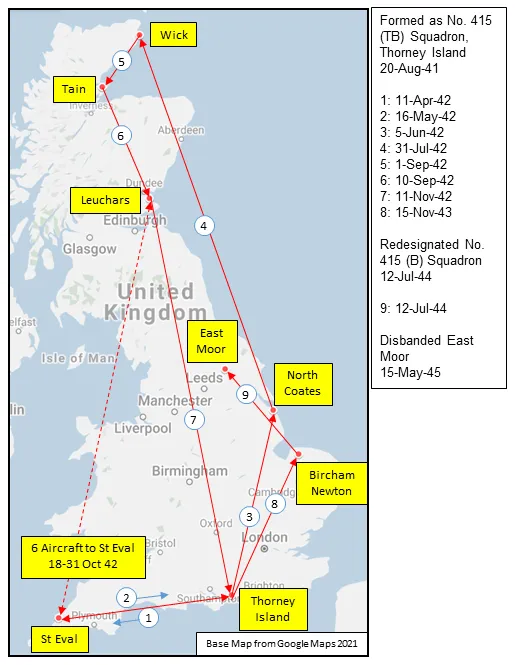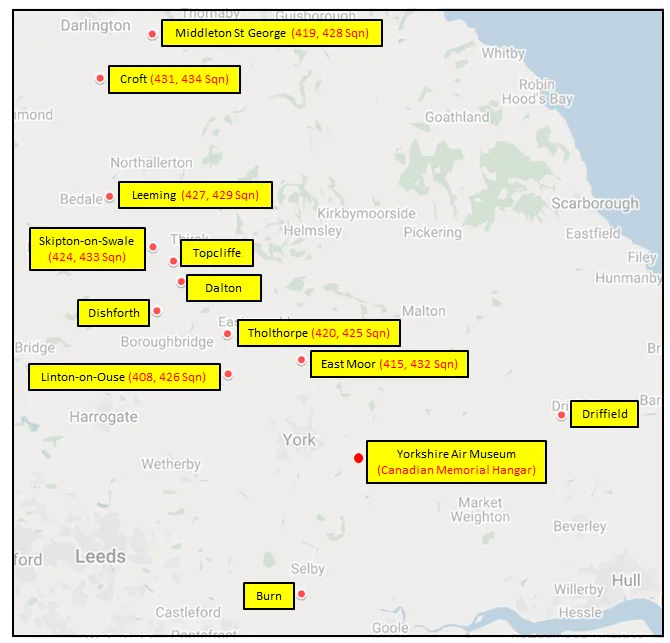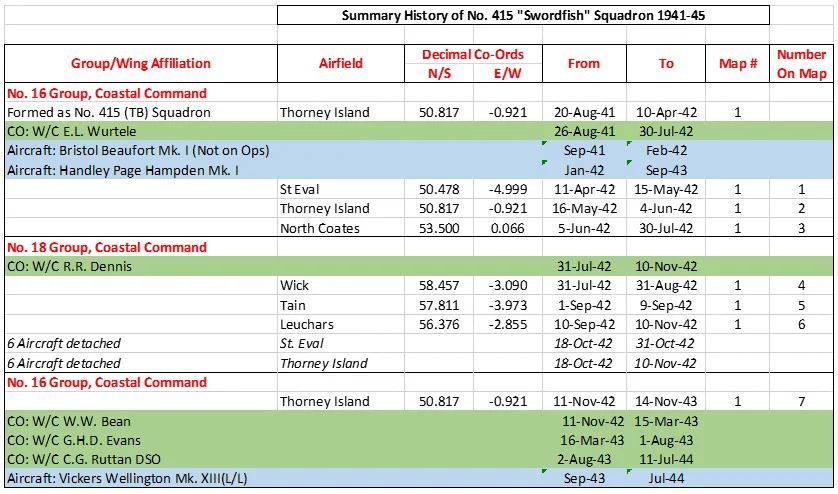415 (B) Sqn- Squadron Ad Metam ("Swordfish")
History of the Squadron during World War II (Aircraft: Beaufort I, Hampden I, Wellington XIII, Albacore I, Halifax III & VII)

The squadron was the 13th RCAF squadron formed overseas, at Thorney Island, Hampshire, England  on August 20, 1941. It was a originally a torpedo bomber squadron, briefly flying Bristol Beaufort Mk 1 (but not operationally) before transferring to Handley Page Hampden aircraft, with the squadron letters GX. The squadron flew from a number of bases as part of Coastal Command Nos 16 and 19 Groups. Over the course of 1942, these bases ranged from the south of England (St. Eval, Cornwall) to the north of Scotland (Wick, Caithness). In November 1942, it settled at Thorney Island for a year before moving to Bircham Newton, Norfolk, in November 1943. From September and October 1943, the squadron flew Wellington Mk. XIII and Fairey Albacore Mk. I, the latter having the squadron code of NH. The squadron was active on D-Day, laying smoke screens for the Allied shipping. After D-Day, there was less need for maritime operations, and the squadron was designated 415(B), was equipped with Handley-Page Halifax III and VII aircraft, and joined 6 Group (RCAF) of Bomber Command, flying from East Moor, Yorkshire
on August 20, 1941. It was a originally a torpedo bomber squadron, briefly flying Bristol Beaufort Mk 1 (but not operationally) before transferring to Handley Page Hampden aircraft, with the squadron letters GX. The squadron flew from a number of bases as part of Coastal Command Nos 16 and 19 Groups. Over the course of 1942, these bases ranged from the south of England (St. Eval, Cornwall) to the north of Scotland (Wick, Caithness). In November 1942, it settled at Thorney Island for a year before moving to Bircham Newton, Norfolk, in November 1943. From September and October 1943, the squadron flew Wellington Mk. XIII and Fairey Albacore Mk. I, the latter having the squadron code of NH. The squadron was active on D-Day, laying smoke screens for the Allied shipping. After D-Day, there was less need for maritime operations, and the squadron was designated 415(B), was equipped with Handley-Page Halifax III and VII aircraft, and joined 6 Group (RCAF) of Bomber Command, flying from East Moor, Yorkshire  (RCAF No 62 Base),where it remained until the end of hostilities. Its squadron code was changed to 6U [this is according to Moyes and Wikipedia, but Kostenuk gives "GU", which may be a misprint]. Its last mission was on April 25, 1945. The squadron was disbanded at East Moor on May 15, 1945.
(RCAF No 62 Base),where it remained until the end of hostilities. Its squadron code was changed to 6U [this is according to Moyes and Wikipedia, but Kostenuk gives "GU", which may be a misprint]. Its last mission was on April 25, 1945. The squadron was disbanded at East Moor on May 15, 1945.
In the course of the war, the squadron flew 1645 torpedo bomber operations for a cost of 33 aircraft, and was credited with 5 ships sunk, with 2 damaged and 2 others shared. In its bomber role, 1608 sorties were flown for the loss of 22 aircraft, dropping 5041 tons of bombs and 798 tons of incendiaries. The crews were awarded 1 DSO, 86 DFC's and 1 Bar to DFC, 1 GM and 9 DFM's. Battle Honours were: Atlantic 1942, English Channel and North Sea 1942-44, France and Germany 1944-45 Biscay Ports 1944, Ruhr 1944-45, German Ports 1944-45, Normandy 1944, Rhine, Biscay 1942-43.Wikipedia, Kostenuk and Griffin
Squadron History (Bomber Command Museum PDF)
Maps for Movements of 415 Squadron 1941-45
 MAP 1: 415 Squadron Movements Dec 1941-Aug-42 (right-click on image to display enlarged in new tab) |
 MAP 2: 6 Group Bomber Bases 1943-45 |
415 Squadron History Summary 1941-45

415 Squadron History Summary 1941-45 Page 2

History of the Squadron Post-WWII (Aircraft: Argus, Aurora)
The squadron was re-established as a Maritime Patrol squadron on 1 June 1961 at RCAF Station Summerside, Prince Edward Island  , and equipped with the Canadair CP-107 Argus. The Squadron was quick to establish a Canadian endurance record on 26 July 1961, flying 30 hours and 20 minutes, non-stop. During its two decades at Summerside, the Swordfish squadron conducted a variety of missions including anti-submarine, fisheries and pollution, and Northern sovereignty patrols, operating from an ever-increasing number of deployment locations. In 1964, the Squadron assumed the Search and Rescue duties for the Maritime Air Command. In 1981, all the Maritime Patrol Squadrons converted to the Lockheed CP-140 Aurora aircraft and all the East Coast CP-140 squadrons were consolidated at Canadian Forces Base (CFB) Greenwood
, and equipped with the Canadair CP-107 Argus. The Squadron was quick to establish a Canadian endurance record on 26 July 1961, flying 30 hours and 20 minutes, non-stop. During its two decades at Summerside, the Swordfish squadron conducted a variety of missions including anti-submarine, fisheries and pollution, and Northern sovereignty patrols, operating from an ever-increasing number of deployment locations. In 1964, the Squadron assumed the Search and Rescue duties for the Maritime Air Command. In 1981, all the Maritime Patrol Squadrons converted to the Lockheed CP-140 Aurora aircraft and all the East Coast CP-140 squadrons were consolidated at Canadian Forces Base (CFB) Greenwood  . On the afternoon of 24 July 1981, Argus 736, call sign "Sidney 02", conducted a fly-past for a ceremonial parade to celebrate 415 Squadron’s welcome to Greenwood; its Change of Command ceremony, and, the last official Canadian Forces flight of the Argus. In 1982, the Squadron received its Standard in recognition of 25 years of dedicated service to the Crown and the people of Canada.
. On the afternoon of 24 July 1981, Argus 736, call sign "Sidney 02", conducted a fly-past for a ceremonial parade to celebrate 415 Squadron’s welcome to Greenwood; its Change of Command ceremony, and, the last official Canadian Forces flight of the Argus. In 1982, the Squadron received its Standard in recognition of 25 years of dedicated service to the Crown and the people of Canada.
Operationally, Iraq’s invasion of Kuwait in 1990 prompted Canada to send a naval task group to enforce the United Nations’ resolutions. 415 Squadron was tasked to support this task group during its work-up phase during transit from Halifax to the Mediterranean Sea. The Aurora exercised the self-defense capability of the Canadian Task Group and provided surface surveillance. In 1993, Operation SHARP GUARD brought crews from 415 Squadron to Sigonella, Sicily,  where they flew surveillance patrols in the Adriatic in support of the United Nation’s arms embargo of the Former Republic of Yugoslavia. The Squadron later participated in Operation ASSISTANCE, providing humanitarian assistance to the people of Manitoba during the great flood of 1997. Throughout the 80s and 90s, anti-submarine warfare training and anti-submarine patrols remained the focal point for 415 Squadron. With the end of the Cold War and new asymmetric threats emerging, the Aurora fleet became more involved in overland missions; to align the CP140 fleet with this new reality, all the CP140 squadrons were rebranded as Long Range Patrol (LRP) Squadrons. 415, along with the other LRP Squadrons, were active participants in Operation APOLLO, deploying crews to the Arabian Sea region in support of the American-led Campaign Against Terrorism (CAT) following the events of September 11, 2001. The first two crews rotated through on deployments of six months duration. For the remainder of the operation, crews were rotated every 56 days. The CP-140 commitment to Operation APOLLO ended in July 2003.
where they flew surveillance patrols in the Adriatic in support of the United Nation’s arms embargo of the Former Republic of Yugoslavia. The Squadron later participated in Operation ASSISTANCE, providing humanitarian assistance to the people of Manitoba during the great flood of 1997. Throughout the 80s and 90s, anti-submarine warfare training and anti-submarine patrols remained the focal point for 415 Squadron. With the end of the Cold War and new asymmetric threats emerging, the Aurora fleet became more involved in overland missions; to align the CP140 fleet with this new reality, all the CP140 squadrons were rebranded as Long Range Patrol (LRP) Squadrons. 415, along with the other LRP Squadrons, were active participants in Operation APOLLO, deploying crews to the Arabian Sea region in support of the American-led Campaign Against Terrorism (CAT) following the events of September 11, 2001. The first two crews rotated through on deployments of six months duration. For the remainder of the operation, crews were rotated every 56 days. The CP-140 commitment to Operation APOLLO ended in July 2003.
As a follow-on to Operation APOLLO, the LRP fleet, under the direction of 1 Canadian Air Division Headquarters, developed a Squadron Vanguard posture for future potential missions. 415 Squadron was the first unit selected, holding Vanguard from 1 April to 30 September 2004, maintaining a high readiness to rapidly deploy worldwide. In September 2004, coincident with the close of 415 Squadron’s Vanguard liability period, came the call to support NATO naval units in the Mediterranean conducting Operation ACTIVE ENDEAVOUR, with the mission to deter, monitor and intercept potential threats of terrorism in the Mediterranean Sea; to defend NATO member nations against terrorists operating at sea; and, to demonstrate resolve and presence in the campaign against terrorism. By mid-October, one crew and support staff from 415 Squadron along with 14 and 19 Wing (Comox) technicians and aircrew, were in theatre and flying Operation SIRIUS missions out of Sigonella. Soon thereafter, on 29 July 2005, 415 Squadron was stood down for a second time.
In 2015, it was decided to merge the capabilities and expertise of 14 SES and MPEU into a single unit that would optimize frontline operator and engineering input into the ongoing development of the platform, and the associated mission/training support systems. This would allow for a more efficient, holistic approach to deal with the software/hardware complexities and to fully realise the vast potential of the AIMP-upgraded Aurora, now dubbed the CP140M. As such, after a 10-year absence, 415 Squadron and the Swordfish were stood up to once again proudly serve the government and people of Canada.





 Canadian Virtual War Memorial
Canadian Virtual War Memorial Commonwealth War Graves Commission
Commonwealth War Graves Commission Find-A-Grave.com
Find-A-Grave.com Library and Archives Canada Service Files (may not exist)
Library and Archives Canada Service Files (may not exist)